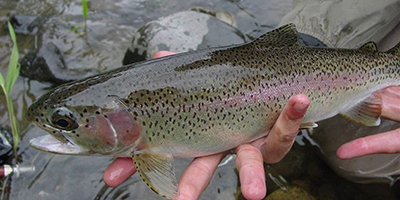April 21, 2020
DEP Milestones: It’s 1984,
Success Is Hatched in Warren County’s Pequest Valley

Streams, ponds and lakes in New Jersey have been stocked with rainbow trout for the spring fishing season. Photo: New Jersey Division of Fish & WildlifeIt’s spring trout season in New Jersey and have we got a fish story for you. Really, it is a fish story – and a successful one, at that.
First, we’ve reeled in some details about angling for trout these days in the Garden State:
- About 570,000 rainbow trout, raised at the Pequest Trout Hatchery in Warren County, have been stocked into the state’s streams, ponds and lakes. (Fun fact: The brook trout – also called speckled trout, brookies or speckles – was designated as the official state fish in 1992.)
- Though state parks and forests have been closed since April 7, anglers can drop their lines at the state’s 122 Wildlife Management Areas.
- Social distancing is critical. A minimum six-foot social distance between anglers must be maintained at all times.
- A fishing license and trout stamp are required for anglers ages 16 and older; children 15 and younger, and N.J. residents aged 70 and older can fish without a license. Find licensing and stamp information here.
- Get updates on trout fishing on the N.J. Division of Fish & Wildlife page.
And now, a look at 1984 …
In the spring of 1984, the first fish reared at the Pequest Trout Hatchery and Natural Resource Education Center in Warren County were released into streams, ponds and lakes across New Jersey.
The new $11.8 million hatchery, completed in 1982, had taken over the trout program from the Charles O. Hayford Hatchery in Hackettstown, which had been built in 1912. Development of the land surrounding the older Hackettstown hatchery had degraded the facility’s spring-fed water supply over the years, endangering the more sensitive cold-water trout. In contrast, the new pathogen-free hatchery, situated in the Pequest Valley, drew its source water from a pristine aquifer surrounded by 4,000 acres of protected land purchased in the 1950s to preserve the aquifer’s water quality.
In early April, then-superintendent Kurt Powers told a reporter from the Millville Daily: “The new hatchery is much more efficient. We are not limited by water quality and quantity, or by temperature. The trout stop growing when the water is frozen or too hot. Here, we always have 50-degree water.”
By the end of the 1984 spring trout season, more than 600,000 brook, brown and rainbow trout – averaging almost 10½ inches – had been stocked from the Pequest Hatchery.
###